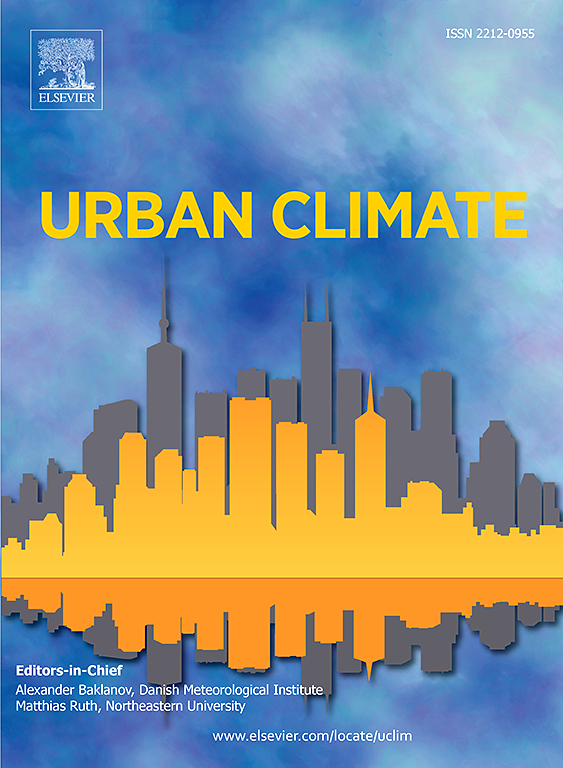Coastal and anthropogenic heat impacts on PBL processes during extreme summer thunderstorm precipitation in New York City
IF 6
2区 工程技术
Q1 ENVIRONMENTAL SCIENCES
引用次数: 0
Abstract
Urban extreme precipitation is a crucial study topic due to its growing societal impact and limited understanding of its processes. This study examines the extreme summer precipitation event that occurred in coastal New York City (NYC) on July 17, 2018, using observations and simulations. Severe flooding was caused throughout the City by the thunderstorm event, which had a maximum rainfall of 44 mm and an Urban Heat Island (UHI) intensity of 8 °C. The study employs two high-resolution weather model simulations: one uses the Building Effect Parameterization (BEP), while the other incorporates with the BEP, Building Energy Model (BEM), an anthropogenic heat source, and a variable building drag coefficient.
Forensics of the event show that increasing temperatures, and a strong UHI ahead of an approaching storm in the northwest initiated an urban storm cell near Bronx borough. The northwest-moving thunderstorm merged with the active urban cell and intensified the precipitation. Surface data indicates classic UHI signatures, such as pre-storm City-warming and post-storm cooling. The BEP + BEM model performed better than the BEP-only model by better simulating anthropogenic heat flux and projecting a greater UHI effect (3.8 vs. 2 °C). This improved simulation of anthropogenic heat produced high surface temperatures that strengthened low-level moisture convergence with the City, enhancing precipitation. The results highlight the key role played by anthropogenic heat in altering mesoscale atmospheric phenomena, strengthening storm intensity in coastal-urban environments. The findings of urban and anthropogenic processes on precipitation are transferable for improved urban-weather forecast and for planning resiliency of cities.
纽约市夏季极端雷暴降水过程中沿海和人为热对PBL过程的影响
城市极端降水由于其日益增长的社会影响和对其过程的有限理解而成为一个至关重要的研究课题。本研究利用观测和模拟分析了2018年7月17日发生在纽约市沿海地区的夏季极端降水事件。雷暴事件造成全市严重洪灾,最大降雨量44毫米,城市热岛强度8°C。该研究采用了两种高分辨率天气模式模拟:一种使用建筑效应参数化(BEP),另一种结合了BEP、建筑能源模型(BEM)、人为热源和可变建筑阻力系数。事件的取证表明,气温上升,以及西北部即将到来的风暴前的强烈热岛,在布朗克斯附近引发了一个城市风暴单体。向西北移动的雷暴与活跃的城市单体合并,降水增强。地面数据显示了典型的热岛特征,如风暴前城市变暖和风暴后变冷。通过更好地模拟人为热通量和预测更大的热岛效应(3.8 vs. 2°C), BEP + BEM模式比仅BEP模式表现更好。这种改进的人为热模拟产生了高地表温度,加强了低层水汽与城市的辐合,增强了降水。这些结果强调了人为热在改变中尺度大气现象,增强沿海城市环境风暴强度方面发挥的关键作用。城市和人为过程对降水的影响结果可用于改善城市天气预报和城市规划弹性。
本文章由计算机程序翻译,如有差异,请以英文原文为准。
求助全文
约1分钟内获得全文
求助全文
来源期刊

Urban Climate
Social Sciences-Urban Studies
CiteScore
9.70
自引率
9.40%
发文量
286
期刊介绍:
Urban Climate serves the scientific and decision making communities with the publication of research on theory, science and applications relevant to understanding urban climatic conditions and change in relation to their geography and to demographic, socioeconomic, institutional, technological and environmental dynamics and global change. Targeted towards both disciplinary and interdisciplinary audiences, this journal publishes original research papers, comprehensive review articles, book reviews, and short communications on topics including, but not limited to, the following:
Urban meteorology and climate[...]
Urban environmental pollution[...]
Adaptation to global change[...]
Urban economic and social issues[...]
Research Approaches[...]
 求助内容:
求助内容: 应助结果提醒方式:
应助结果提醒方式:


